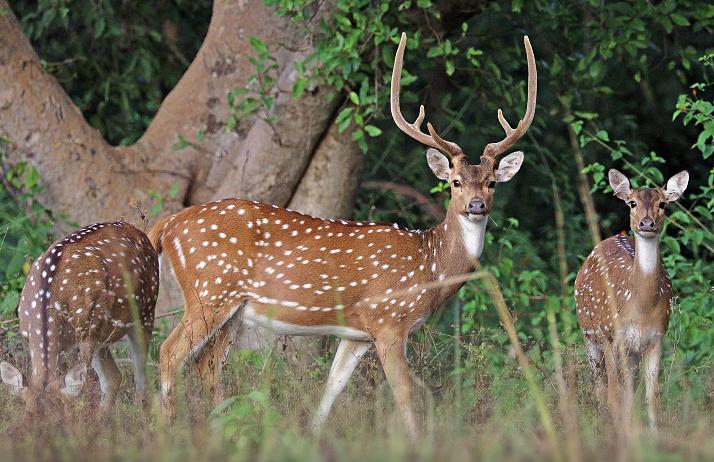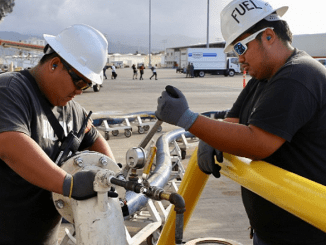
WAILUKU, Maui, Hawaii, August 14, 2025 (ENS) – Hawaii Governor Josh Green, MD, declared an emergency caused by the overpopulation of axis deer plus an ongoing drought on the island of Maui two weeks ago. It was the 22nd time the governor has issued such a statement since March 23, 2022, when he first declared the overpopulation of axis deer, an invasive species in Hawaii, to be an emergency.
In 1868, Hong Kong, then a British colony, gifted eight axis deer to King Kamehameha V, then ruler of the Hawaiian Islands. These eight deer were placed on the island of Moloka’i as a future source of protein for the islanders.
Axis deer breed all year round and their numbers have boomed. A 2021 population estimate suggested a total of 145,000 to 167,000 deer for Maui County, with Maui having up to 70,000, Moloka’i at 60,000, and Lana’i up to 37,000.
Extra-dry conditions have turned too many deer into an emergency. Maui County was designated as a primary natural disaster area due to drought conditions by the U.S. Department of Agriculture in 2022. The islands continue to experience “moderate to extreme drought conditions,” Governor Green declared, citing data from the National Oceanic and Atmospheric Administration and the National Weather Service.
The drought underlying the axis deer crisis is anticipated to continue indefinitely. “Farmers and ranchers will continue to suffer damages and economic losses, and Maui County agricultural operations will continue to suffer from harm and damage caused by starving axis deer,” the governor said.
The state’s deer management strategies include creating buffers and erecting, reinforcing, and repairing fence lines to keep the deer away from roadways, airports, and runways, and taking action to immediately cull the axis deer, reducing the size of their herds.
Despite intense efforts to control their number by hunting, axis deer have propagated to at least 60,000 animals, and the population is growing at about 30 percent annually, a number which “cannot currently be sustained by the environment in Maui County,” Governor Green declared.

“The large number of axis deer in Maui County have devastated pasture forage and much of the vegetation that is already scarce due to persistent drought conditions,” Green said, explaining that the destruction of vegetation has forced Maui’s axis deer to migrate into agricultural and developed areas seeking food and water.
The proliferation of axis deer has caused financial problems for Hawaii and for Maui Country.
In September 2022, the Hawaii Department of Agriculture, HDOA, opened an emergency loan program to help farmers with the costs associated with the overpopulation of axis deer on Maui. These low-interest emergency loans are intended to offer some relief for farmers and ranchers trying to manage their losses and assist with the costs of fencing and other mitigation measures.
As of September 2023, HDOA’s Agricultural Loan Division reported that it had approved eight loans under this emergency program, totaling $1,140,420.
HDOA, through discussions with the ranchers of the Hawaii Cattlemen’s Council, still finds that axis deer present an emergency on three islands in Hawaii – Maui, Moloka’i, and Lana’i.
Deer Could Spread Disease
“The effects of the large numbers of axis deer migrating into agricultural and developed areas include the possible spread of disease in the environment,” Governor Green declared in his most recent proclamation.
“The high axis deer population comingling with livestock is suspected to be behind the largest bovine tuberculosis (bTB) outbreak on Molokai in the past 50 years,” he said.
“The Hawaii Department of Land and Natural Resources has tested hundreds of animals, including axis deer, no positive results have been detected; and although control measures over the past years have minimized the potential for spread to and between livestock, axis deer can serve as a reservoir for infection and reinfection of livestock operations on Molokai and therefore reducing axis
deer numbers is crucial to preventing further outbreaks,” Governor Green said.
Techniques have been implemented to prevent infected axis deer from close contact with livestock, such as increasing fence heights, however, such measures are costly to farmers and ranchers,” the governor acknowledged.
Solutions in Progress: Meat, Fences, Traps
The meat of the axis deer, or venison, is prized as it is very lean, and the meat of the culled deer can be sold to the public.
The Hawaii Dept. of Agriculture, HDOA, has convened a Meat Processing Task Force, which has met once. The HDOA is coordinating with the U.S. Dept. of Agriculture Safety and Inspection Services, the Hawaii Food Bank, and the Maui Food Bank on meat processing rules, regulations, and donations.
In November 2024, the Meat Processing Task Force awarded a contract to conduct a study to determine the feasibility of expanding meat-processing capacity in the state to the University of Hawaii.
The Meat Processing Task Force is working towards a strategic framework to ensure safe and nutritious food products for consumers and has initiated a survey of hunting groups, food distributors, slaughterhouses, and meat processors.
One axis deer meat company is already in business. Maui Nui Venison, a venison producer and seller on Maui, was founded in 2015 by Jake and Ku‘ulani Muise. Its night harvesting and field infrared light technology allows the deer to be harvested in a less stressful manner, unique in the world, the company says.
Commercial harvesting of wild Axis deer on private land in Hawaii is legal and requires both federal and state permits along with extensive USDA oversight for food safety.

Maui Nui Venison says a USDA inspector attends the entire duration of its harvest and, along with a USDA veterinarian, inspects every single animal before approving it as safe for human consumption. “As an exotic meat, inspection is voluntary, the cost of which falls to us as opposed to other meats (such as beef, pork, lamb, etc.) whose inspection services are covered by the federal government,” the company states on its website.
“All harvesting is done entirely at night to make the process stress-free for the deer. They are never baited, fenced, penned, or corralled and remain wild until the moment of harvest. To achieve this, we, again, rely on our Forward Looking Infrared, FLIR, technology to inspect and harvest each animal without it being aware of our presence,” the company explains.
“There are initiatives to increase the commercial slaughter of axis deer to help decrease the population and provide a sustainable food source,” Governor Green recognized in his emergency proclamation.

Still, he acknowledged that, “Farmers and ranchers still need sufficient time to assess the impacts that are being and will continue to be incurred by their operations in order to identify and quantify the level of financial support they will need to sustain their businesses and prevent a major loss and closure of agricultural operations in Maui County.”
Three strategic deer fences for Maui, totaling over 11 miles, are in the works to control the deer. The state Department of Land and Natural Resources, Division of Forestry and Wildlife, DOFAW, used the governor’s emergency proclamation on July 2, 2024, to submit contract approvals and order all materials for the fences.
And DOFAW anticipates using any future emergency proclamation to obtain contracts for, materials for, and install additional deer fences across the landscape of Maui Nui, which translates as beloved, sacred Maui.
Purchase of materials and supplies for remote trap fabrication for 16 deer traps were also authorized under the July 2 proclamation.
In addition, DOFAW continues to conduct aerial shoot missions to remove axis deer from remote, hard to reach areas.
DOFAW is continuing its wildlife control permit program in the Department of Hawaiian Homelands Waiohuli/Keokea Unit. The agency reports that over 350 axis deer were removed by the general public and Department of Hawaiian Homelands beneficiaries between February 2024 and July 2024.
DOFAW received a several millions in funding from the state Legislature for fiscal year 2025 specifically for axis deer management. With these funds the agency is offering a financial incentive to private landowners to remove axis deer from their own land on the islands of Maui, Molokai, and Lanai by hunting the deer themselves. Applications closed November 25, 2024. Applicants awarded a contract are eligible to receive up to $50 for each qualifying deer tail presented.
The public will soon know more about these invasive deer. DOFAW has completed an updated axis deer population survey, which was conducted throughout 2024, and is currently working on finalizing that survey for public release. The agency also is finalizing a report on the amount of axis deer taken during 2024 and says it will release that report publicly in the near future.
Featured image: Invasive axis deer on the island of Maui. undated (Photo courtesy Hawaii Dept. of Land and Natural Resources, DLNR)



